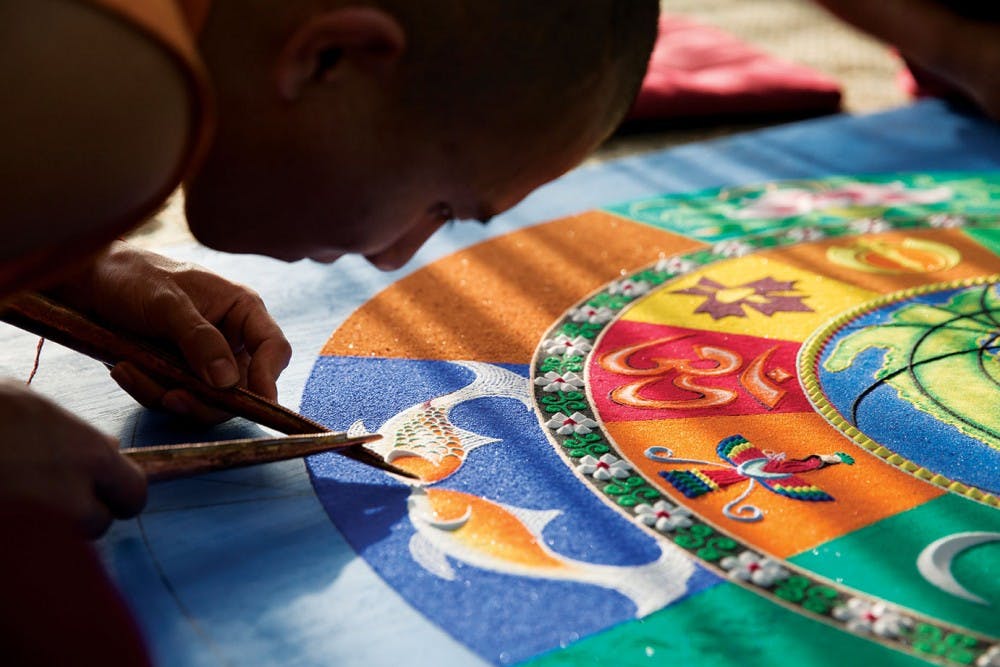Columnist Grace Eberly reflects on the sand mandala that monks are building in Baker Center.
On Monday night, a sand mandala on the fifth floor of Baker Center was accidentally destroyed, probably by an Ohio University custodial worker. On Thursday, it will be destroyed again — this time on purpose.
The mandala, an intricate geometric pattern made entirely from sand, is being built by seven Tibetan monks from the Labrang Tashi Kyil Monastery in Dehra Dun, India. The monks are currently touring the United States in order to raise much-needed funds for their monastery. The organization of which I am the president, the Comparative Religion Club, and Brian Collins, the Gawande Chair in Indian Religion and Philosophy, were thrilled to make a sizable donation to the monastery in exchange for the monks’ construction of a sand mandala.
The mandala, which is painstakingly created from individual dyed grains of sand, is a meditative tool which serves to guide Buddhist practitioners along the path to enlightenment. As the intricate designs take shape, the monks meditate upon the mandala, imagining it as a three-dimensional space in which the deity resides. This mandala, called a World Peace Mandala, is somewhat different; it is not a deity mandala. Instead, the World Peace Mandala features iconography from the world’s great religious traditions. As the monks impeccably layer the Star of David, the Hindu Om and the Latin cross (among other religious symbols), they invoke a sense of peace and harmony for the benefit of all sentient beings.
Some mandalas are so complex that they take whole teams of monks upward of one month to complete. This mandala, which is much simpler by comparison, was started on Monday afternoon and will be finished by Thursday evening. Just as soon as they have completed it, the mandala will be destroyed — again. But this time, it won’t be the act of a misinformed janitor. No, the monks themselves, who will have just spent close to 29 mentally and physically taxing hours perfecting the mandala, will sweep up the sands, place them in a vessel and dump them in the Hocking River.
{{tncms-asset app="editorial" id="eb07d6e8-cdcf-11e5-90a3-2f8395cd881d"}}
Have you ever made a house out of playing cards? Have you ever absent-mindedly bumped your elbow on the table and then watched in horror as the whole thing came tumbling down?
That’s how I felt on Tuesday morning when I learned that the mandala had been destroyed. I — who had not laid one single grain of sand on the mandala — was furious.
The monks? They laughed.
This whole process — the creation and subsequent destruction of the mandala — is itself a tangible illustration of Buddhist philosophy, meant to demonstrate the transitory nature of all of life. Nothing is permanent. Everything must come to pass. Our thoughts. Our emotions. Our bodies. And yes, even our mandalas.
The monks know this reality all too well. Their cultural heritage — a heritage which has preserved this ancient art form — is increasingly jeopardized by the Chinese occupation of Tibet.
Each year, between 2,500 and 3,500 Tibetans flee their ancestral homeland, dangerously trekking across the Himalayan mountains as refugees. Kalsang and Jigme, two of the monks visiting OU this week, made the arduous journey when they were in their twenties.
No wonder they didn’t cry over spilled milk (sand).
And so as I write this while watching the monks work away, skipping their tea breaks so that they can still complete the mandala on time, I am inspired by their visit in a way that I had not intended to be. So, to whoever destroyed the mandala on Monday night, thank you. Without you, maybe I wouldn’t have learned anything at all.
Grace Eberly is a senior studying world religions and biology. The closing ceremony for the mandala is tomorrow at 5:30 p.m. on the fifth floor of Baker Center. Have a question about it? Email Grace at ge713313@ohio.edu.






